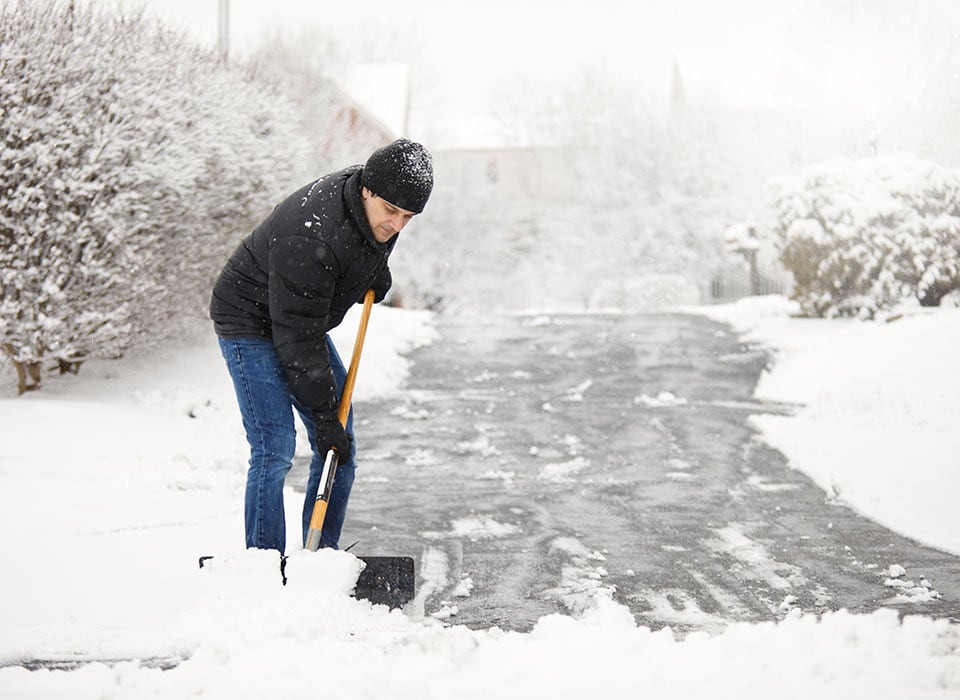Winter has arrived and along with it comes the decorative lights and the dangerous mixtures of snow and ice. The once-dry sidewalks and driveways are now slippery, giving even the simplest of activities a higher risk for injury.
So, before you reach for the shovel or the sled, check out these common causes of winter injuries and their prevention tips to help keep you healthy until spring.
Slipping on snow or ice
Walking outside in winter can be extremely dangerous. What may seem like a pool of water may be a sheet of slick ice. Stepping onto the ice without being prepared can lead to a dangerous fall and severe injury.
Even if you are able to regain your balance in the nick of time and only skid on the ice, the awkward motions allowing you stay upright can cause other injuries such as pulled muscles in the back.
Anyone and everyone is at risk of injury from falling or slipping during the winter months, but seniors are especially vulnerable.
Types of injuries
- Head injuries such as concussions
- Severe bruises
- Muscle sprains and ligament strains
- Broken bones (commonly hip and wrist)
- Back injuries
Prevention tips
- Slow down. Take your time and keep your stride shorter.
- Wear shoes/boots that have good traction. If you need to wear different shoes at work, carry your work shoes and change into them at the office.
- If there’s a handrail, use it.
- Put salt or sand down on your home’s walkways, steps, and driveways.
Shoveling snow
Clearing a walkable path to the house is key for your safety following a snowfall. But in your effort to make your home safer, you are actually performing a task that has an incredibly high incidence of injury. Over the last decade in the United States, an average of 11,500 emergency room visits from shoveling snow occur each year.
Shoveling is a full body workout, requiring muscles from many areas to be doing their fair share, and not everyone is physically prepared. The repetitive motions of twisting, digging, and lifting while shoveling can put severe strain and stress on your body.
Types of injuries
- Soft tissue injuries to the lower back
- Cuts to the hands and head
- Neck strains
- Fractures
- Heart attack
Prevention tips
- Get your body loose and the blood flowing with some stretches before shoveling.
- Don’t rush. Take your time and take breaks.
- Wear shoes/boots with good traction.
- Hydrate. Hydrate. Hydrate.
- If shoveling the snow is too strenuous, hire someone else to do it.
Driving
When it snows, the world doesn’t stop. You may still need to go to the grocery store or drop your kids off at school.
Driving in the snow and ice is extremely dangerous and can put you and others at high risk for motor vehicle injuries. Each year, an average of 116,800 people are injured and 1,300 people are killed from motor-vehicle accidents due to winter weather conditions in the United States alone.
Types of injuries
The types of injuries from motor-vehicle accidents can range dramatically from minor bruises and pulled muscles to severe trauma injuries that need immediate medical attention.
Prevention tips
Keep an ice scraper in your car.
- Keep a first-aid kit in your car.
- If your car has four-wheel-drive, use it.
- Drive the speed limit always.
- If you can, have winter-grade tires installed.
- Have your vehicle inspected and make sure your brakes are working properly.
Colliding during winter sports
When snow starts to fall, some prefer to stay inside, but others like to stay active and fit by partaking in numerous winter sports. From the more advanced sports of ice hockey, skiing, and snowboarding to the childhood favorites of sledding and snowball fights, the snow can be a great way to keep you and your family moving.
As with any sport however, there is a risk of injury, especially if you aren’t taking the necessary safety precautions.
Types of injuries
- Knee pain and strain from shock absorption
- Broken bones and fractures (shoulder, arm, wrist, leg)
- Head injuries such as concussions
- Muscle and ligament strains
Prevention tips
- Always stretch before any type of physical exercise.
- Wear the proper protective equipment (helmet, goggles, gloves, snow pants, etc.).
- If you’ve never skied or snowboarded before, take a lesson to learn how to fall safely.
- When sledding, choose a hill that isn’t too steep and has a long flat runway at the bottom. Don’t choose a hill that ends near a street, fence, or pond.
- Always sled during the day.
If you are injured from a winter weather related injury, first asses the severity. Many muscle injuries can be treated with over-the-counter anti-inflammatories and rest. If the injury appears to be slightly more severe, locate your nearest Ortho On Call. Ortho On Call is open Mondays through Saturdays in all regions and open Sundays in specific areas for walk-in, no-appointment-needed, urgent orthopedic care.

